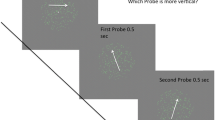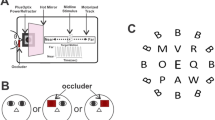Summary
Observers looked monocularly into a tunnel, with gratings on the left and right sides drifting toward the head. An exposure period was followed by a test with fixed gratings. With fixation points, left and right retinal fields could be stimulated selectively. When exposure and test were on the same retinal fields, but fixation was on opposite sides of the tunnel during exposure and test periods, aftereffects of retinal sweep and of perceived looming were in opposite directions. The two effects tended to cancel, yielding no perceived aftereffect. When they did occur, aftereffects in the retinal and the looming directions were equally likely. Cancellation was significantly more likely in the experimental conditions than in the control, when fixation always remained on the same side. When areas of retinal stimulation in the exposure and test periods did not overlap, cancellation was less frequent and aftereffects of looming were more frequent. Results were not significantly different for left and right visual fields, indicating that cortical vs. subcortical OKN pathways do not influence the illusion. Vection resulted for 16 of 20 observers under one or another of our conditions.
Similar content being viewed by others
References
Anstis, S. M., & Gregory, R. L. (1965). The aftereffect of seen motion: the role of retinal stimulation and eye movements. Quarterly Journal of Experimental Psychology, 17, 173–174
Barlow, H. B., & Hill, R. M. (1963). Evidence for a physiological explanation of the waterfall phenomenon and figural aftereffects. Nature (London) 200, 1345–1347
Beverley, K. I., & Regan, D. (1979). Separable aftereffects of changingsize and motion-in-depth: different neural mechanisms. Vision Research 19, 727–732.
Brandt, T., Dichgans, J., & Büchele, W. (1974). Motion habituation: Inverted self-motion perception and optokinetic after-nystagmus. Experimental Brain Research 30, 331–338.
Harris, L. R., & Smith, A. T. (1992). Second-order motion stimuli do not evoke optokinetic nystagmus. Investigative Ophthalmology and Visual Science 33, 1152.
Hoffmann, K. P. (1983). Control of the optokinetic reflex by the nucleus of the optic tract in the cat. In A. Hein & M. Jeannerod (Eds.), Spatially oriented behavior, (pp. 135–153). New York: Springer-Verlag.
Howard, I. (1982). Human visual orientation. New York: Wiley.
Mack, A., Hill, J., & Kahn, S. (1989). Motion aftereffects and retinal motion. Perception 18, 649–655.
Regan, D., & Beverley, K. I. (1978). Illusory motion in depth: aftereffect of adaptation to changing size. Vision Research 18, 209–212.
Walls, G. L. (1953). Interocular transfer of after images. American Journal of Optometry (Archives of the American Academy of Optometry) 30, 57–60.
Author information
Authors and Affiliations
Rights and permissions
About this article
Cite this article
Bridgeman, B., Nardello, C. Conflict between aftereffects of retinal sweep and looming motion. Psychol. Res 56, 78–82 (1994). https://doi.org/10.1007/BF00419714
Received:
Accepted:
Issue Date:
DOI: https://doi.org/10.1007/BF00419714




